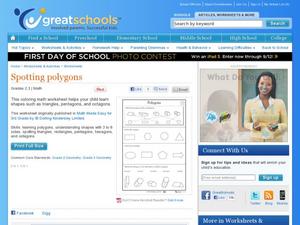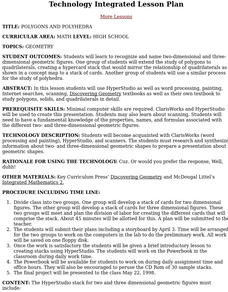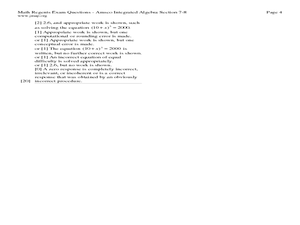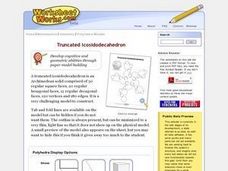Curated OER
Three-Dimensional Play Dough
Fourth graders make models of three-dimensional figures and then use these play dough figures to observe and count the vertices, edges, and faces of the figure.
Curated OER
Spotting Polygons
See all sides of the story with a worksheet on geometric shapes! After studying the example at the top, which matches polygons with solid figures, second graders circle shapes that are named in the directions. Next, they match polygons...
Curated OER
Marshmallow Geometry
In this three-dimensional shapes geometry lesson, learners identify geometric solids and name their properties. They define "face," "edge," and "vertex," and construct geometric solids using marshmallows as vertices and toothpicks as edges.
Curated OER
Recognizing Three Dimensional Shapes
In this 3D shape worksheet, students review the names of 4 shapes on page one and color each shape a specific color to match the key on page two.
Curated OER
Guess My Shape
Learners play a game with shapes. They work in groups to identify the names and characteristics of various shapes. They give each other clues to see if others can identify the shape being described. This is a great hands on activity.
Annenberg Foundation
Geometry 3D Shapes: Euler's Theorem
How do you get a theorem named after you? Euler knows what it takes! The third lesson of five asks pupils to use an interactive activity to compare the faces, vertices, and edges of seven different three-dimensional solids. They use...
Curated OER
How many edges do I need to cut in order to open a cube?
Students problem solve to open a cube to create different shapes. In this problem solving lesson plan, students are given a cube and the shapes to open it up to, and they have to cut the cube open to make certain shapes. This gives them...
Curated OER
Geometric Shapes: Review of 2D and 3D Figures
In this geometric shapes worksheet, students identify 4 drawings as polygons or not, 1 drawing as regular or not and then write the name of 3 solid figures.
Curated OER
2: Isle of Shapes - Based on the Puerto Rico Quarter Reverse
Students identify both two and three-dimensional shapes. In this geometric shapes lesson, students listen to a teacher led lesson about the island of Puerto Rico. They look at the symbols and shapes on "Puerto Rico Quarter Reverse" on a...
Curated OER
Math Who Am I? Worksheet 3
In this math who am I worksheet, students read geometric shapes and math terms clues, fill in the blanks, and check their answers by circling each third letter in boxes with answers. Students write eight answers.
Curated OER
Pyramids and Prisms: Guler's Formula
Sixth graders detect and categorize the attributes of geometric shapes to solve problems. In this geometry lesson, 6th graders construct a variety of polyhedra. Students recognize the relationships between two dimensional and three...
Curated OER
Truncated Dodecahedron
In this math instructional activity, students build a truncated dodecahedron. This is a solid shape with 12 regular decagonal faces and 20 equilateral triangular faces. Students build this shape to assist in developing their cognitive...
Curated OER
Our Geometric World
Third graders explore the attributes of polygons. In this geometric shapes lesson plan, 3rd graders review quadrilaterals, squares, rectangles, triangles, pentagons, hexagons, and octagons in order to create hanging polygons. Students...
Curated OER
Using the Web to Explore Shapes
Third graders research the Internet to locate geometric designs in familiar buildings. They review shapes, solids, angles and symmetry as they research websites of familiar buildings in Louisville. They record the information they see...
Curated OER
Spacemobiles
Aspiring astronauts construct a space vehicle using cylinders, cones, spheres, and rectangular prisms. This is an engaging method of learning about three-dimensional shapes. Note that the word cylinder is constantly misspelled in the...
Curated OER
Color Me Square
Second graders identify and describe basic geometric solids. Working as a class, 2nd graders describe geometric solids using the proper vocabulary and counting faces, bases, corners, and edges. In pairs, students use a computer drawing...
Curated OER
Prisms, Pyramids, and Nets
Students compare and contrast the characteristics of prisms and pyramids. In groups, they are given different colored construction paper to make rectanglar prisms. They identify the shapes of the faces and record the number of faces,...
Curated OER
Geometry Journal: Classifying Solids
In this geometry worksheet, 10th graders respond to journal prompts related to prisms and classifying solid shapes. The two page worksheet contains nine questions. Answers are included.
Curated OER
Circles to Spheres
Students investigate circles and spheres. In this space shapes instructional activity, students compare and contrast two-dimensional and three-dimensional shapes. Students investigate the relationship between plane and space shapes.
Curated OER
Polygons And Polyhedra
Pupils recognize and name two-dimensional and three-dimensional geometric figures. One group of students will extend the study of polygons to quadrilaterals while another group of pupils will extend the study of polygons to quadrilaterals.
Curated OER
Twenty Volume Of Solids Problems
In this volume worksheet, students solve twenty volume of various solids problems. The solids examined include: cylinders, cubes, rectangular prism, including how the volumes of these figures change with increased in length. The...
Curated OER
Using Geometric Shapes in Architecture
Third graders identify two and three dimensional shapes used in architectural designs by viewing images on the Internet. In this geometry lesson, 3rd graders create their own building designs and identify the geometric shapes that will...
Curated OER
Truncated Icosidodecahedron
In this math worksheet, students use a paper model to build a truncated icosidodecahedron. The worksheet includes a model that is to be cut out and put together by the student. There is an option to include a small preview of the...
Curated OER
Truncated Icosahedron
In this math worksheet, learners build a model of a truncated icosahedron. This shape has 12 regular pentagonal faces and 20 regular hexagonal faces. An option to include a preview of the finished model is included for the teacher.

























